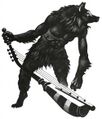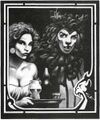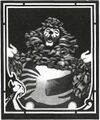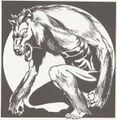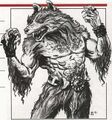Wolfwere: Difference between revisions
1d4chan>Nubnuber No edit summary |
m (17 revisions imported) |
||
| (10 intermediate revisions by 7 users not shown) | |||
| Line 1: | Line 1: | ||
[[File:Wolfwere MM 2e.png|thumb|right|Wolfweres are often confused with werewolves due to the fact that [[derp|they are identical in both appearance and function.]]]] | [[File:Wolfwere MM 2e.png|thumb|right|Wolfweres are often confused with werewolves due to the fact that [[derp|they are identical in both appearance and function.]]]] | ||
'''Wolfweres''' are one of the sillier monsters in [[Dungeons & Dragons]] to have nonetheless persisted throughout the editions. As their name implies, they are "reverse [[werewolves]]", a [[therianthrope]] breed which in its native form is a wolf with [[regeneration]] and a human-like level of intelligence, and which can freely adopt human or half-human forms. They are particularly common in [[Ravenloft]], as the Darklord of Kartakass is a wolfwere. | '''Wolfweres''' are one of the sillier monsters in [[Dungeons & Dragons]] to have nonetheless persisted throughout the editions. As their name implies, they are "reverse [[werewolves]]", a [[therianthrope]] breed which in its native form is a wolf with [[regeneration]] and a human-like level of intelligence, and which can freely adopt human or half-human forms. They are particularly common in [[Ravenloft]], as the [[Darklord]] of Kartakass is a wolfwere. | ||
The basic difference between wolfweres and werewolves is that whilst werewolves are mindless killing machines, wolfweres are highly cunning and intelligent predators who just happen to prefer the flesh of humans and [[demihuman]]s. One of the things that make wolfweres different to werewolves is that they can freely tailor their humanoid forms as they see fit, taking on whichever race and even gender they like - in fact, in AD&D, they explicitly prefer to take on the opposite gender to their current target, in order to more easily seduce them away from safety and kill them. Wolfweres revile wolfsbane and are compelled to avoid it, and whilst they have no fear of silver, which can prove a deadly mistake to the monster hunter who confuses them for a werewolf, cold iron can hurt them just as badly as silver hurts their counterparts. | |||
Wolfweres are ''extremely'' solitary by nature; they prefer the company of normal wolves and their monstrous cousins dire wolves and worgs to that of other wolfweres. In AD&D, the most you will ever see them in is a group of 3, whilst in 3e, you might find a troupe of as many as 5 wolfweres. | |||
In 3rd edition, it's stated that wolfweres often become enamored of attractive humans, but their bestial minds cause them to [[/d/|have difficulties separating lust and hunger]], often getting the two emotions so confused that they end up eating their lover as an expression of love. | |||
Because of the way monsters worked in old-school D&D, there's also the '''Greater''' Wolfwere, a more powerful version that does more damage, can regenerate like a [[troll]], can summon packs of wolves and dire wolves to its aide, is resistant to wolfsbane, and has at least one level in [[bard]]. They are said to be the direct children of the wolfwere [[Darklord]] Harkon Lukas, and 10% of the children of a greater wolfwere and a regular wolfwere will be greater wolfweres in turn. In 3rd edition, they lost the mandatory Bard levels and resistance to wolfsbane (although, in fairness, wolfweres lost the wolfsbane vulnerability themselves), and it's stated that they are only 10% of Lukas' offspring. | |||
Wolfweres and werewolves '''despise''' one another, and try to kill each other whenever they meet. | |||
In AD&D, the meekulbern plant was said to have a 50% chance of sprouting from the corpse of any victim of a greater wolfwere that wasn't either completely eaten or buried properly. In 3e, meekulbern grows automatically wherever humanoid victims of ''any'' wolfweres were killed. The berries of this plant are used to make meekulbrau, a blood-red wine that gives a bonus to Perform (Sing) checks. | |||
The most dangerous part of facing a wolfwere is its song. Wolfweres have a talent for music and often disguise themselves as wandering minstrels or bards, and their songs have an innate ability to make anyone who hears them sluggish and lethargic. Thus slowed, they become easy prey for the wolfwere. | The most dangerous part of facing a wolfwere is its song. Wolfweres have a talent for music and often disguise themselves as wandering minstrels or bards, and their songs have an innate ability to make anyone who hears them sluggish and lethargic. Thus slowed, they become easy prey for the wolfwere. | ||
They have not appeared at all in 5th edition, and were replaced with the [[Loup-garou]] in Ravenloft, leaving only their long-time fellows the [[Jackalwere]]s to carry on as the last of the antherions. | |||
==Gallery== | ==Gallery== | ||
| Line 11: | Line 22: | ||
Wolfwere S4.png|1e | Wolfwere S4.png|1e | ||
Wolfwere 1e.png | Wolfwere 1e.png | ||
Wolfwere | Wolfwere RA1.jpg|2e | ||
Wolfwere RA1 1.jpg | |||
Wolfwere RA1 2.jpg | |||
Wolfwere MC1.jpg | |||
Wolfwere MC Ravenloft.jpg | Wolfwere MC Ravenloft.jpg | ||
Wolfwere DoD2.jpg|3e | Wolfwere DoD2.jpg|3e | ||
</gallery> | </gallery> | ||
[[Category: Dungeons & Dragons]] [[Category: Monsters]] | {{D&D-Therianthropes}} | ||
[[Category:Dungeons & Dragons]] | |||
[[Category:Monsters]] | |||
[[Category:Therianthropes]] | |||
Latest revision as of 12:06, 23 June 2023
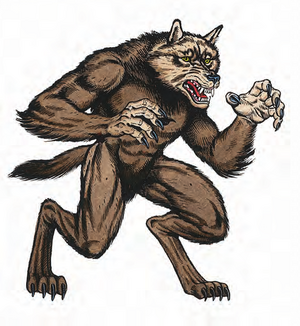
Wolfweres are one of the sillier monsters in Dungeons & Dragons to have nonetheless persisted throughout the editions. As their name implies, they are "reverse werewolves", a therianthrope breed which in its native form is a wolf with regeneration and a human-like level of intelligence, and which can freely adopt human or half-human forms. They are particularly common in Ravenloft, as the Darklord of Kartakass is a wolfwere.
The basic difference between wolfweres and werewolves is that whilst werewolves are mindless killing machines, wolfweres are highly cunning and intelligent predators who just happen to prefer the flesh of humans and demihumans. One of the things that make wolfweres different to werewolves is that they can freely tailor their humanoid forms as they see fit, taking on whichever race and even gender they like - in fact, in AD&D, they explicitly prefer to take on the opposite gender to their current target, in order to more easily seduce them away from safety and kill them. Wolfweres revile wolfsbane and are compelled to avoid it, and whilst they have no fear of silver, which can prove a deadly mistake to the monster hunter who confuses them for a werewolf, cold iron can hurt them just as badly as silver hurts their counterparts.
Wolfweres are extremely solitary by nature; they prefer the company of normal wolves and their monstrous cousins dire wolves and worgs to that of other wolfweres. In AD&D, the most you will ever see them in is a group of 3, whilst in 3e, you might find a troupe of as many as 5 wolfweres.
In 3rd edition, it's stated that wolfweres often become enamored of attractive humans, but their bestial minds cause them to have difficulties separating lust and hunger, often getting the two emotions so confused that they end up eating their lover as an expression of love.
Because of the way monsters worked in old-school D&D, there's also the Greater Wolfwere, a more powerful version that does more damage, can regenerate like a troll, can summon packs of wolves and dire wolves to its aide, is resistant to wolfsbane, and has at least one level in bard. They are said to be the direct children of the wolfwere Darklord Harkon Lukas, and 10% of the children of a greater wolfwere and a regular wolfwere will be greater wolfweres in turn. In 3rd edition, they lost the mandatory Bard levels and resistance to wolfsbane (although, in fairness, wolfweres lost the wolfsbane vulnerability themselves), and it's stated that they are only 10% of Lukas' offspring.
Wolfweres and werewolves despise one another, and try to kill each other whenever they meet.
In AD&D, the meekulbern plant was said to have a 50% chance of sprouting from the corpse of any victim of a greater wolfwere that wasn't either completely eaten or buried properly. In 3e, meekulbern grows automatically wherever humanoid victims of any wolfweres were killed. The berries of this plant are used to make meekulbrau, a blood-red wine that gives a bonus to Perform (Sing) checks.
The most dangerous part of facing a wolfwere is its song. Wolfweres have a talent for music and often disguise themselves as wandering minstrels or bards, and their songs have an innate ability to make anyone who hears them sluggish and lethargic. Thus slowed, they become easy prey for the wolfwere.
They have not appeared at all in 5th edition, and were replaced with the Loup-garou in Ravenloft, leaving only their long-time fellows the Jackalweres to carry on as the last of the antherions.
Gallery[edit]
-
1e
-
-
2e
-
-
-
-
-
3e
| The Therianthropes of Dungeons & Dragons | |
|---|---|
| Therianthrope | Laridian • Loup-garou • Loup du Noir • Lythari • Red Falcon • Seawolf • Selkie • Shifter • Swanmay • Thebestyn • Vodoni • Werebaboon • Werebadger • Werebat • Werebear • Wereboar • Werecat • Werecrocodile • Werefox • Werehyena • Werejackal • Werejaguar • Werekillerwhale • Wereleopard • Werelion • Werepanther • Wererat • Wereraven • Wereray • Wereseal • Weresnake • Wereshark • Werespider • Wereswine • Weretiger • Werewalrus • Werewolf |
| Antherions | Aranea • Song Dragon • Jackalwere • Nawidnehr • Wolfwere |
| Third Party | Werealligator • Wereanaconda • Werebunny • Werecheetah • Werecobra • Weremustela • Wereoctopus • Werepossum • Wereraccoon • Werestag • Werewolverine |


